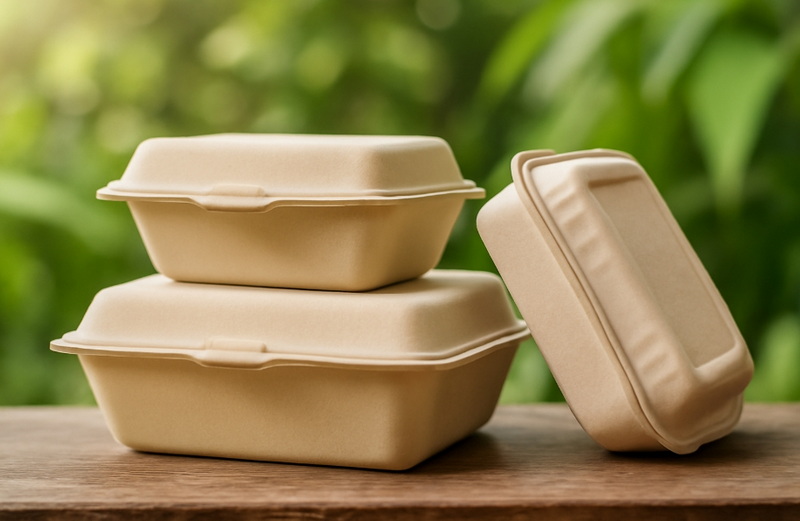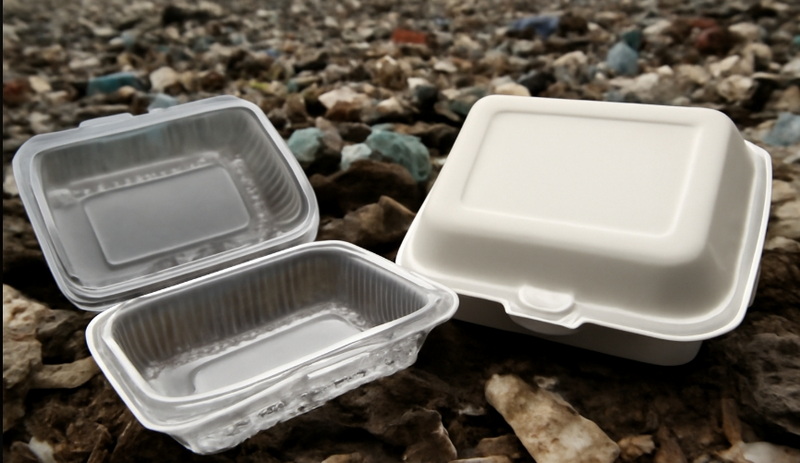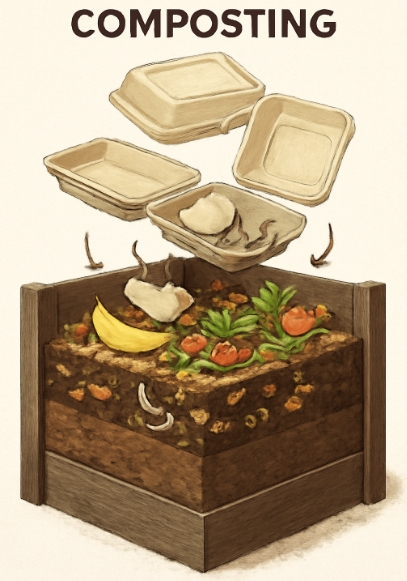
Content Menu
● The Rise of Disposable To Go Lunch Boxes
● The Environmental Impact of Traditional Disposable To Go Lunch Boxes
>> Resource Consumption and Manufacturing
>> Transportation and Distribution
>> Waste Generation and Landfill Accumulation
>> Ocean Pollution and Microplastics
● Eco-Friendly Alternatives: What's Changing?
>> Compostable and Biodegradable Materials
>>> Plant Fiber and Bagasse
>>> Certifications Matter
>>> Recyclable Paper and Cardboard
>> Compartmentalized Designs
>>> Benefits of Compartment Disposable To Go Lunch Boxes
>> PFAS-Free and Toxin-Free Options
● Are Eco-Friendly Disposable To Go Lunch Boxes Truly Sustainable?
>> Composting Infrastructure
>> Consumer Behavior
>> Transportation and Sourcing
● The Role of Businesses and Consumers
>> For Businesses
>> For Consumers
● Practical Tips for Choosing Eco-Friendly Disposable To Go Lunch Boxes
● Conclusion
● FAQ: Disposable To Go Lunch Boxes
>> 1. What materials are used in eco-friendly disposable to go lunch boxes?
>> 2. How do I know if a disposable to go lunch box is truly compostable?
>> 3. Are biodegradable disposable to go lunch boxes as durable as plastic ones?
>> 4. What should I do with my disposable to go lunch box after use?
>> 5. Do eco-friendly disposable to go lunch boxes cost more than traditional ones?
In today's fast-paced world, the demand for convenience has led to a surge in the use of disposable to go lunch boxes. These containers are everywhere-from bustling city delis to food trucks, school cafeterias, and even corporate boardrooms. But as the mountains of single-use packaging pile up, a crucial question arises: Are disposable to go lunch boxes truly eco-friendly, or are they quietly contributing to a growing environmental crisis?
This comprehensive article explores the environmental impact of disposable to go lunch boxes, compares the different materials used, and examines whether modern innovations are making a meaningful difference. We'll also look at practical tips for making better choices and answer the most pressing questions about this ubiquitous item.

The Rise of Disposable To Go Lunch Boxes
The disposable to go lunch box has become a symbol of modern convenience. Whether you're grabbing a salad on your lunch break or ordering takeout for dinner, these containers offer a quick, mess-free solution for transporting food. Their popularity is driven by several factors:
- Busy lifestyles demanding on-the-go meals
- Hygiene concerns, especially post-pandemic
- The growth of food delivery services
- An increasing variety of food options requiring specialized packaging
However, this convenience comes at a cost-one that is often hidden from the consumer's view.
The Environmental Impact of Traditional Disposable To Go Lunch Boxes
Resource Consumption and Manufacturing
Traditional disposable to go lunch boxes are commonly made from plastics or polystyrene foam. The production of these materials relies heavily on non-renewable fossil fuels. Extracting and processing petroleum for plastics is energy-intensive and emits significant greenhouse gases. Additionally, the manufacturing process often involves chemicals that can pose risks to both human health and the environment.
Transportation and Distribution
Once manufactured, these lunch boxes must be transported-often over long distances-to retailers and food service providers. This adds another layer of energy consumption and emissions, further increasing their carbon footprint.
Waste Generation and Landfill Accumulation
The most significant environmental issue with disposable to go lunch boxes is their short lifespan. Used once and discarded, they quickly become waste. Most end up in landfills, where they can persist for hundreds of years, taking up valuable space and leaching chemicals into the soil.
Ocean Pollution and Microplastics
Improperly discarded plastic lunch boxes frequently find their way into rivers and oceans. There, they break down into microplastics, which are ingested by marine life and enter the food chain, posing threats to ecosystems and human health.
Eco-Friendly Alternatives: What's Changing?
The growing awareness of environmental issues has spurred innovation in the design and materials used for disposable to go lunch boxes. Let's examine the most prominent eco-friendly options.
Compostable and Biodegradable Materials
Plant Fiber and Bagasse
Modern eco-friendly disposable to go lunch boxes are often made from plant fibers such as sugarcane bagasse, bamboo, or cornstarch. These materials are renewable, biodegradable, and compostable, breaking down naturally in the environment without leaving harmful residues.
Key Benefits:
- Made from rapidly renewable resources
- Compostable under the right conditions, reducing landfill waste
- Free from toxic chemicals and allergens
- Lower carbon footprint compared to traditional plastics
- Sturdy, leak-resistant, and suitable for hot or cold foods
Certifications Matter
Look for certifications such as BPI (Biodegradable Products Institute) or TUV OK Compost, which verify that the lunch boxes will break down in commercial composting facilities.
Recyclable Paper and Cardboard
Some disposable to go lunch boxes are made from recycled paper or cardboard. These can be recycled again, provided they are not contaminated with food waste. However, the recycling process itself consumes energy and resources, and not all facilities accept food-soiled packaging.
Compartmentalized Designs
Benefits of Compartment Disposable To Go Lunch Boxes
Innovative designs now include compartmentalized lunch boxes, which keep different foods separate, prevent cross-contamination, and help with portion control. Many of these are made from eco-friendly materials, further reducing their environmental impact.
PFAS-Free and Toxin-Free Options
A growing concern with food packaging is the presence of PFAS (per- and polyfluoroalkyl substances), which are used to make containers water and oil-resistant but are linked to health risks. Modern eco-friendly disposable to go lunch boxes are increasingly PFAS-free, making them safer for both people and the planet.

Are Eco-Friendly Disposable To Go Lunch Boxes Truly Sustainable?
While eco-friendly disposable to go lunch boxes are a significant improvement over traditional plastic or foam options, several factors influence their overall sustainability.
Composting Infrastructure
Compostable lunch boxes require industrial composting facilities to break down efficiently. In areas without such infrastructure, these containers may still end up in landfills, where decomposition is much slower.
Consumer Behavior
Even the most sustainable lunch box is only effective if disposed of correctly. Education and clear labeling are essential to ensure consumers know how to compost or recycle their containers.
Transportation and Sourcing
Although plant-based materials are renewable, transporting raw materials and finished products still generates emissions. Local sourcing and efficient logistics can help reduce this impact.
The Role of Businesses and Consumers
Both businesses and consumers play a crucial role in driving the adoption of eco-friendly disposable to go lunch boxes.
For Businesses
- Choose suppliers with strong environmental credentials
- Offer compostable or recyclable options by default
- Educate customers about proper disposal
- Reduce unnecessary packaging wherever possible
For Consumers
- Opt for restaurants and caterers using sustainable packaging
- Dispose of containers responsibly-compost or recycle when possible
- Consider bringing your own reusable containers when practical
Practical Tips for Choosing Eco-Friendly Disposable To Go Lunch Boxes
- Check the Material: Look for plant-fiber, bagasse, or certified compostable options.
- Look for Certifications: BPI, TUV OK Compost, and FSC are reputable certifications.
- Assess Durability: Eco-friendly doesn't mean flimsy-bagasse and bamboo options are sturdy and leak-resistant.
- Consider Your Needs: Choose compartmentalized designs for meals with multiple components.
- Ask About PFAS: Ensure your lunch box is free from harmful chemicals.
Conclusion
Disposable to go lunch boxes are an integral part of modern life, but their environmental impact cannot be ignored. Traditional plastic and foam containers contribute to pollution, landfill overload, and harm to ecosystems. However, the rise of eco-friendly alternatives-made from renewable, compostable, and toxin-free materials-offers a promising path forward.
The true eco-friendliness of disposable to go lunch boxes depends on the materials used, the availability of proper composting or recycling facilities, and responsible consumer behavior. By making informed choices, both businesses and individuals can significantly reduce their carbon footprint and help protect the planet.
Switching to compostable or biodegradable disposable to go lunch boxes is a simple yet powerful step toward a more sustainable future. Every meal packed in a greener container is a vote for a healthier world.

FAQ: Disposable To Go Lunch Boxes
1. What materials are used in eco-friendly disposable to go lunch boxes?
Eco-friendly disposable to go lunch boxes are typically made from renewable plant fibers such as sugarcane bagasse, bamboo, cornstarch, or recycled paper. These materials are biodegradable, compostable, and often free from harmful chemicals.
2. How do I know if a disposable to go lunch box is truly compostable?
Look for certifications like BPI (Biodegradable Products Institute) or TUV OK Compost. These indicate the lunch box will break down in commercial composting facilities. Check the packaging for clear labeling and certification marks.
3. Are biodegradable disposable to go lunch boxes as durable as plastic ones?
Yes, many biodegradable options made from bagasse or bamboo are sturdy, leak-resistant, and microwave-safe. They can handle both hot and cold foods without compromising performance.
4. What should I do with my disposable to go lunch box after use?
If it's compostable and you have access to a composting facility, compost it. If it's recyclable and clean, place it in the recycling bin. If neither option is available, dispose of it in the regular trash, but try to minimize usage when possible.
5. Do eco-friendly disposable to go lunch boxes cost more than traditional ones?
While prices can be slightly higher due to the use of renewable materials and certifications, the difference is narrowing as demand increases. Many businesses find that the environmental and brand benefits outweigh the small additional cost.

















